Testimonials are highly effective marketing assets that can let your existing customers speak on behalf of your business, leading to better branding and conversion rates from your website. Testimonial templates can help make it easier for you to collect testimonials, customize and brand them, and share them across your landing pages and even social media channels.
The best testimonial template should include:
- A clear message on how your company addresses a problem faced by your target audience.
- Fields for the speaker’s attribution details to enhance credibility.
- Space for your company’s logo and colors to reinforce brand identity.
- A layout that highlights key points of the testimonial, even during quick scrolling.
In our view, it’s also better if templates are flexible enough for various use cases — such employee testimonials, customer testimonials, product reviews, etc.
From customizable graphics, to plugins, to dynamic embedded galleries, we’ll run through the pros and cons of several options below, so you can find the best solution for your business.
In the second half of this post, we’ll explain the advantages of video testimonials over written reviews. We’ll also show you how to use the video templates included with our tool, Vocal Video, to embed eye-catching testimonial videos and galleries on any page of your website.
The Best Ways to Showcase a Written Testimonial on Your Site
You’ve probably already collected reviews from your customers or clients through channels like feedback surveys and third-party sites. If you want to start using testimonials in more areas of your marketing strategy today, using the reviews you already have is the perfect place to begin.
1. Use Your Site’s Quote Block Feature
The first and fastest way to add a testimonial to your website is to create a new quote block in the back end of your site and paste in an existing testimonial. If you use a site builder like WordPress, the testimonial could look something like this:

Using a quote block has three clear advantages for publishing endorsements, client testimonials, and glowing customer reviews…
- The quote block design makes the testimonial stand out against the rest of the page and encourages the visitor to read it in full.
- The quote block style signals that the review came from a different source than the rest of the copy, showing the reader the claims are true and unbiased.
- The quote block function prompts you to add attribution information like the speaker’s name before you publish, so the review has built-in credibility.
The biggest advantage of using a quote block is the speed and ease of use. There’s no need to pay for or learn any web design tools — if you have a written testimonial, you can transform it into a quote block in a few clicks and display it on your site without disrupting the layout.
But as with many quick fixes, there are some potential downsides to be aware of.
Firstly, there’s no guarantee you’ll like the way your site theme formats quote blocks. For example, the font might not match the rest of your branding, or the quoted text could be set smaller than the rest of the copy.
We’ve also found that a quote block works best for single testimonials from a website design perspective. If you have a longer case study text or a testimonial section with reviews from multiple customers, the format can look out of place on the page.
And finally, while you can usually add the speaker’s name and title, it’s often harder to include other beneficial attribution elements that show a testimonial is reliable — like the speaker’s picture or a link to their website.
Graphic design apps make it easy to plug a written testimonial from a survey, interview, or customer feedback email into an eye-catching graphic to add to your site. For example, sites like Canva or Pablo let you search for customizable templates designed for testimonials.
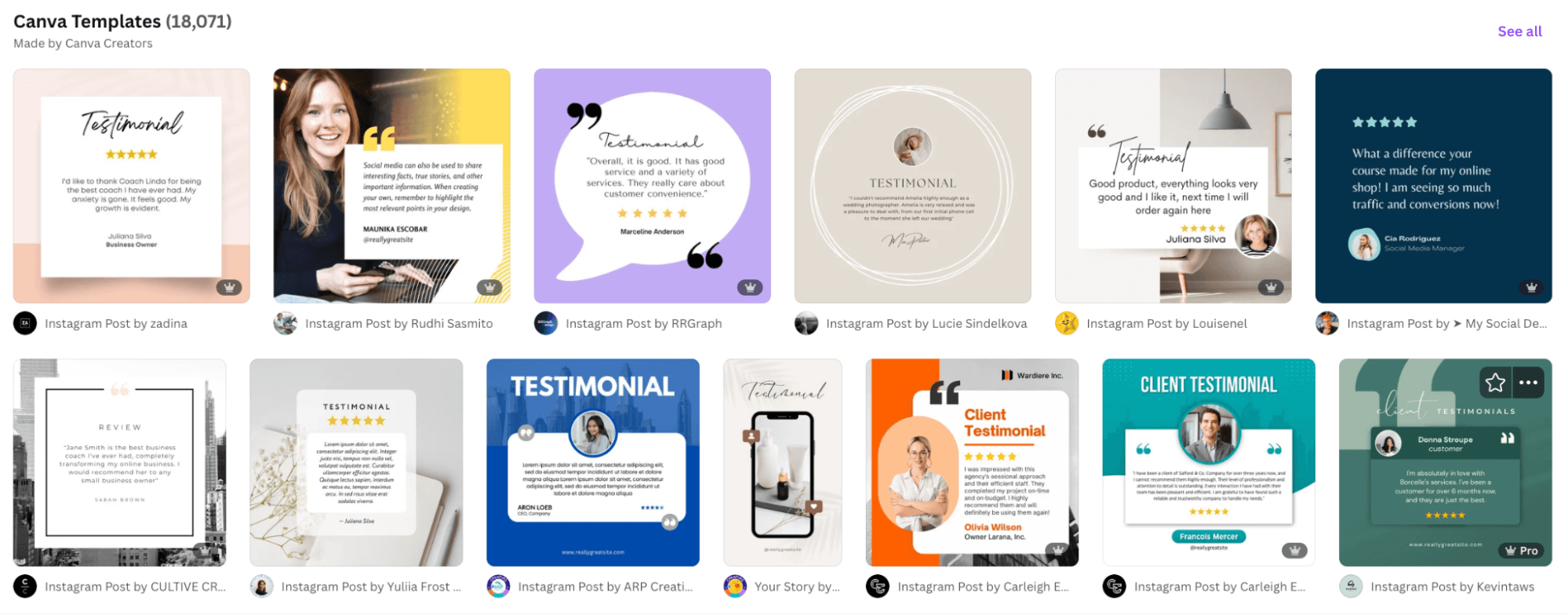
These tools form an integral part of the marketing strategy for many businesses because…
- It’s easy to set up one template and apply it to multiple testimonials, social media posts, or web design elements, which helps you build a unified brand identity.
- New design apps are quick and relatively intuitive to use, so you don’t have to invest hours figuring out a pro-level tool like the Adobe Creative Suite.
- These tools offer a high level of customization to help you get the look you want. For example, in the image below, we uploaded our logo and hex colors to make a testimonial template that matched our brand guidelines.
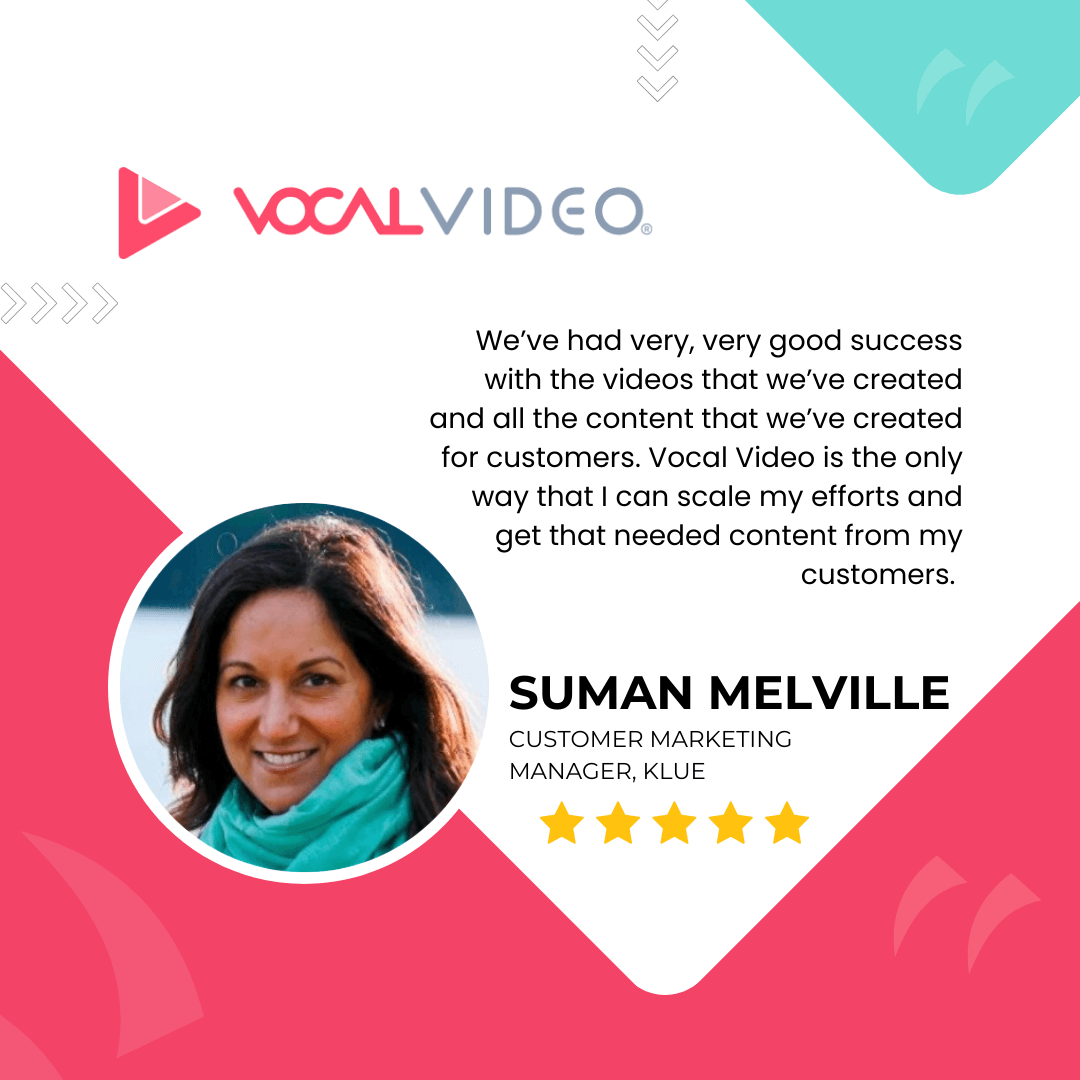
Read more about how Klue uses Vocal Video: Klue Scales Social Proof Across Sales, Marketing, and Customer Success
Having said this, there’s a limit to how convenient graphic design apps can be. Many of the templates you’ll find in their libraries are designed for social media, which means the sizing and format can look out of place on some websites. Plus, if you want to access the full catalog of design elements and repurposing features, you’ll have to subscribe to a pro pricing plan.
If your business has a profile on a review site, you should be able to find a plugin to display the testimonials you collect on that platform.
For example, businesses in the hospitality sector often add a ticker with their TripAdvisor reviews to the home page of their site. Local services might use widgets from review sites like Yelp, and software companies often use TrustRadius is.
Take a look at how Cathedral Payments (who also collect video testimonials with Vocal Video) display their TrustPilot ratings on their website’s homepage.
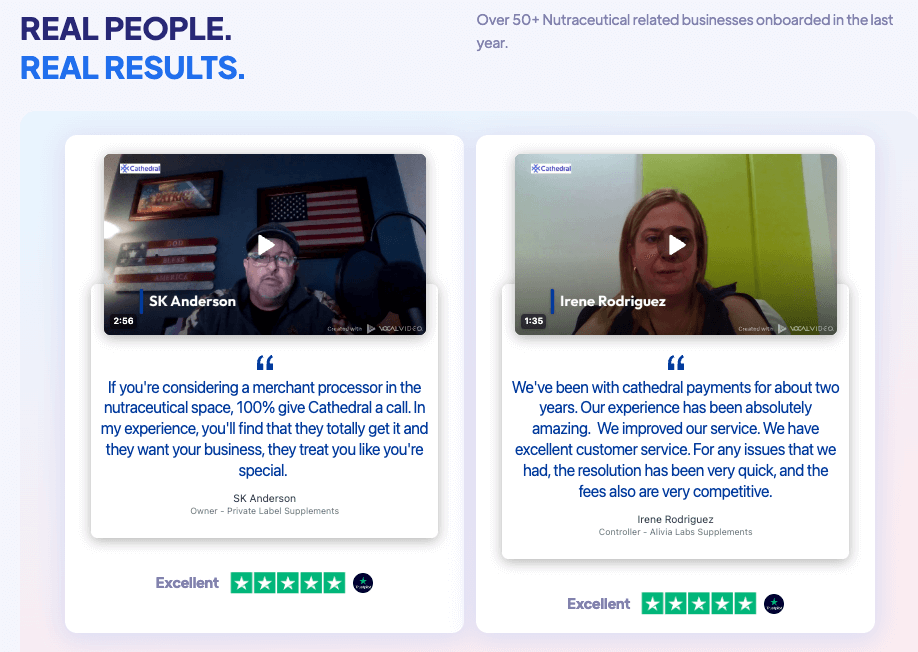
Like the methods we’ve previously discussed, using a testimonial widget on your website has some advantages...
- These plugins mean you can display fresh reviews on your site without manually updating your testimonial page with new reviews when you get them.
- The review sites have strong brand recognition, and potential customers can see they’re independent from your company. This means your website visitors are very likely to trust the reviews they see in a plugin.
The downside, in this case, is maintenance.
Plugins can sometimes be buggy, and even the best-designed examples need to be updated. If you’re slow to catch an issue, a broken plugin is an eyesore and looks unprofessional to people who visit your site. You also run the risk that a plugin will show all your business’ reviews, and not just the best testimonials and success stories you want to share.
For a Reliable Positive Impact, Use Video Testimonials
Written testimonials are a good addition to your website. But if your goal is to strengthen your brand identity, build trust, and give your visitors a deeper understanding of what they can expect from your business, video is the way to go.
Video testimonials are…
- More authentic than written reviews because they show the speaker’s body language and tone as well as the quotes you want to highlight.
- More detailed than survey results because they delve into more aspects of the customer experience and show your audience what makes your business unique.
- More memorable than a simple quote because they show the viewer that other people understand — and have solved — the pain point they’re currently facing.
- More inspiring than a star rating because they explain the benefits of your business in real terms and drive the viewer toward your call to action.
With the latest asynchronous video interview technology, it’s fast and simple to connect with your happy customers and create effective testimonials that reliably boost your website conversions.
How to Use Vocal Video Testimonial Templates on Your Website
Using Vocal Video to gather testimonial examples is a simple three-step process...
- Choose a template video interview collector and customize the questions.
- Share a link to the collector with the customers you want to hear from.
- Get automatically-edited videos, complete with your logo and branding as overlays and opening slides, and share them with your target audience.
With this method, you can collect different types of testimonials that showcase the unique voices of your customers, while fitting effortlessly into your brand.
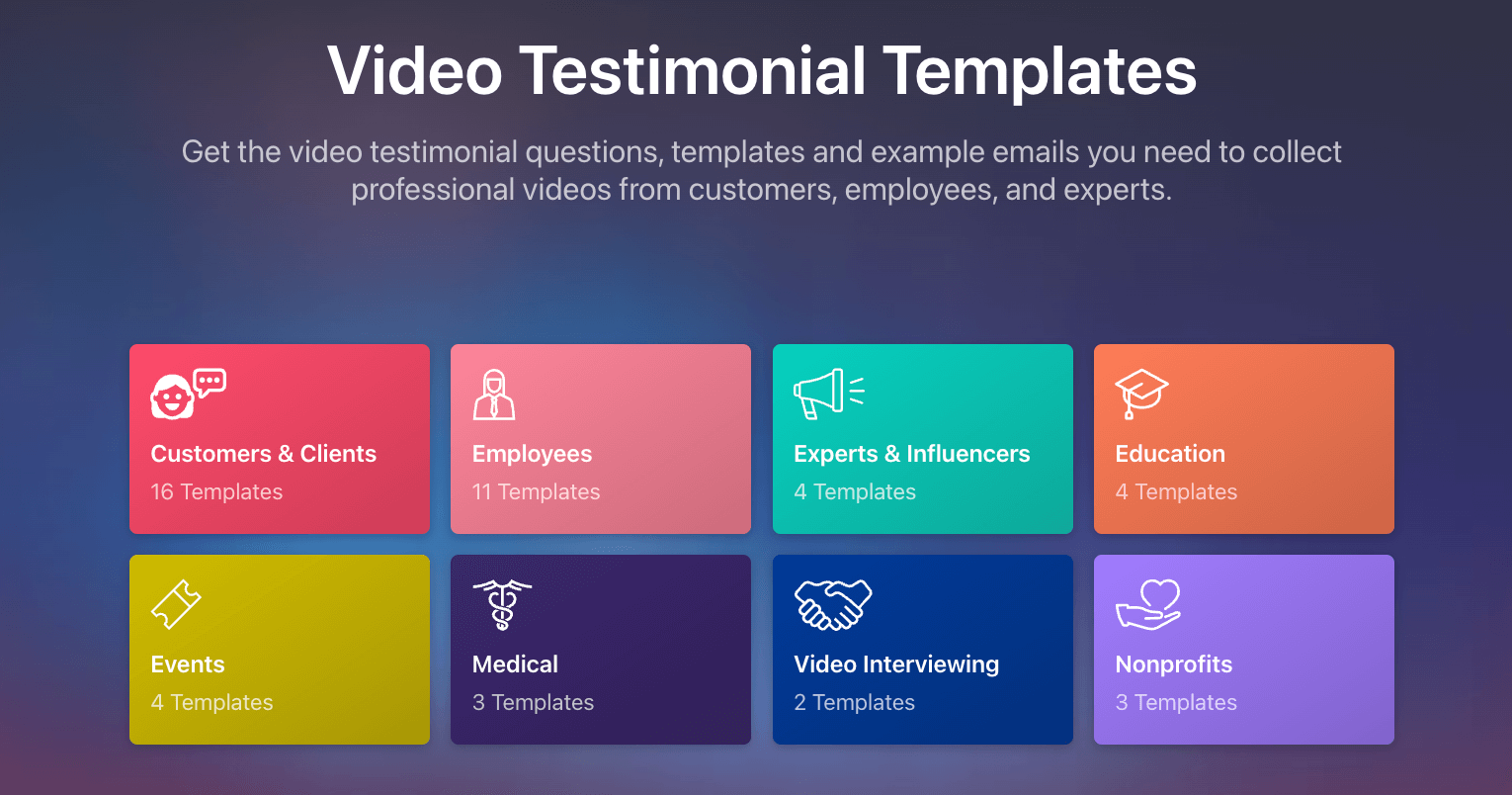
Explore Video Testimonial Templates for Every Use Case
When you choose Vocal Video to help generate social proof for your website, you can choose from over 45 industry-specific testimonial templates to kick-start the process. For example…
Once you’ve chosen your collector and customized the pre-set testimonial questions, upload your logo and set your colors in your brand kit. This defines the elements that we’ll automatically add to all your finished videos.
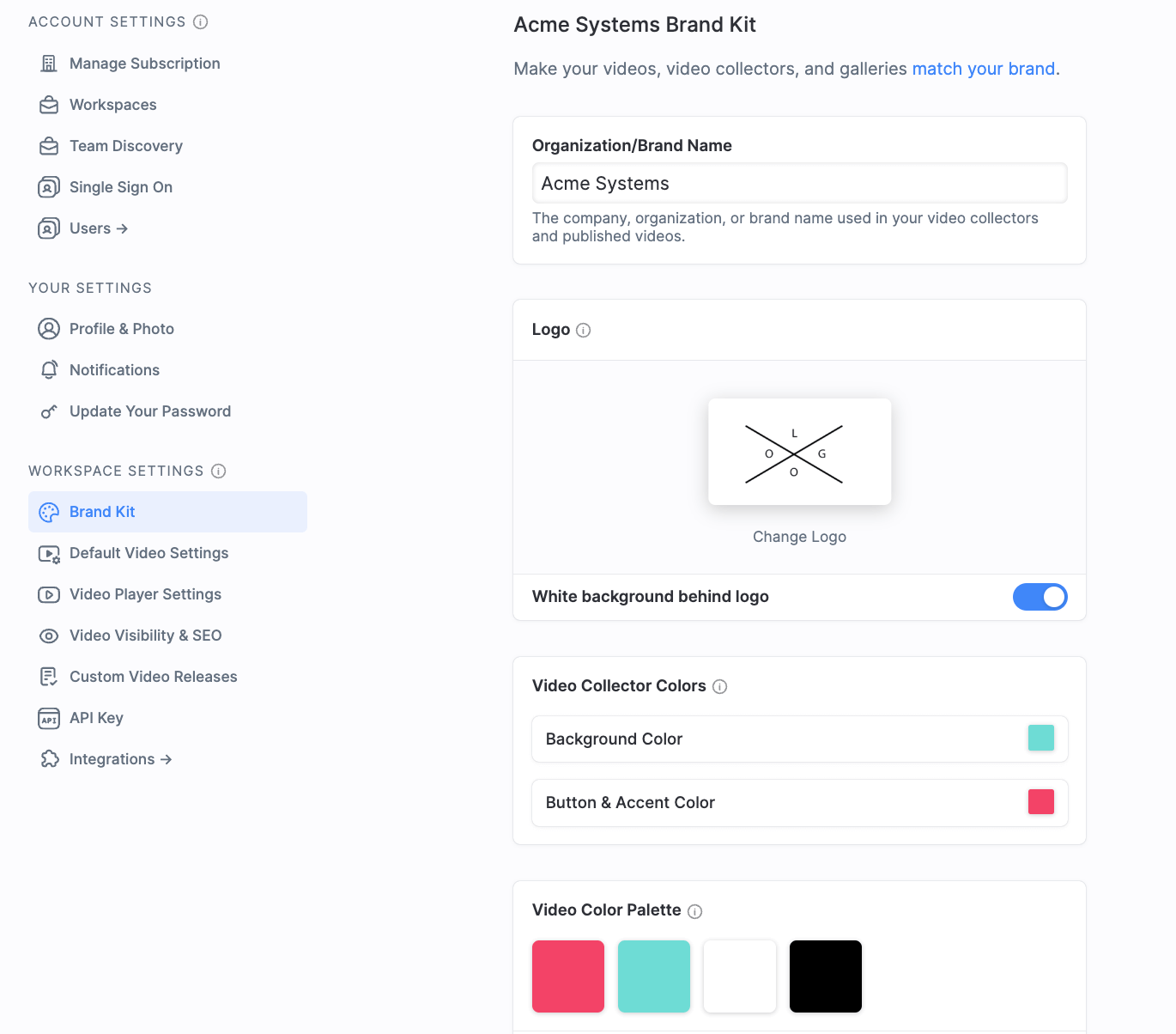
When you’re happy with the template, we’ll generate a URL so you can invite your customers to record their testimonial interviews. The collector — which looks great on any device — will take them through each prompt in turn, record their responses, and thank them for taking part.
Once the recording process is finished, we’ll automatically edit the speaker’s response to each question into a complete video, with template design elements like…
- The branding elements you set in your brand kit.
- The speaker’s name and position as an attribution overlay at the beginning of the video.
- Dynamic transitions between slides and answers.
- Music from our library of royalty-free tracks.
You can switch these elements instantly by selecting a new video theme, or tweak the length and order of the clips using our suite of intuitive editing tools.
Check out this example from Otito Iwuchukwu from the ACCP:
Embed Video Testimonials Seamlessly on Your Website
With Vocal Video, you can access the benefits of video testimonials, collected with custom-built templates, just as easily as you can collect written reviews for your webpages. You don’t need any additional software, equipment, video experience, or coding skills to create a testimonial video that looks at home on any page of your site.
Now, let’s look at some more video testimonial examples for inspiration.
4. Make Testimonial Cards
A testimonial card is a single video with a featured quote. Testimonial cards make a professional impression, and the featured quote grabs attention. Plus, even if your visitor can’t stop scrolling to watch the testimonial in full, they leave with some crucial information.
We’ve found that testimonial cards look great embedded alongside a long-form text (like a case study or news post), as part of a landing page, or as the headline on a review or testimonial page.
Here’s an example of a testimonial card embed made 100% with Vocal Video and used to break up the client success story the Digital Edge marketing agency posted on their website:
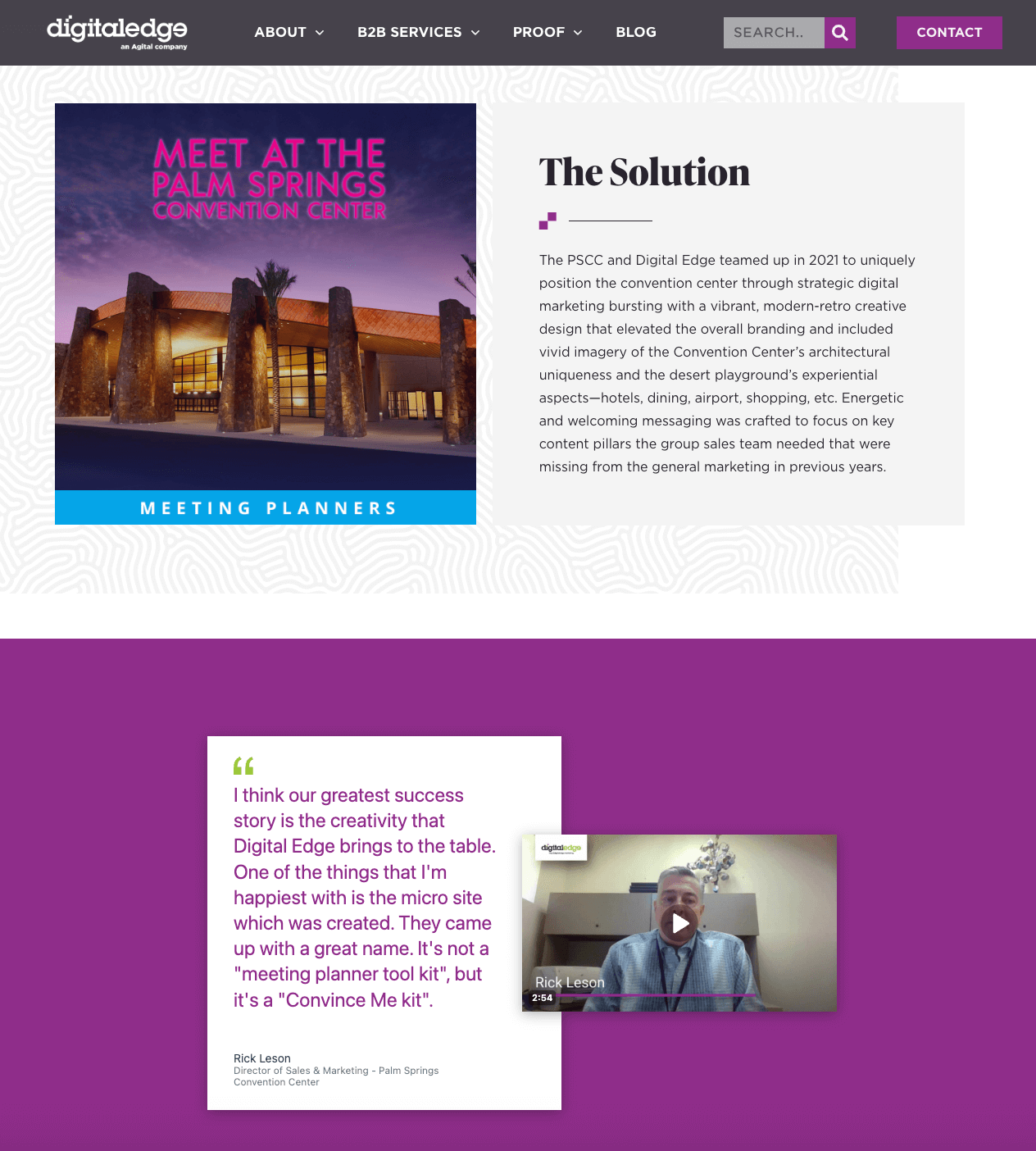
Here, the video card from the client comes after the agency’s description of the partnership, where it effectively proves the results. The featured quote highlights the most effective area of the strategy and provides enough intrigue to encourage the visitor to click on the video and watch the case study interview in full.
To make a testimonial card with Vocal Video …
- Open any of the published video responses in your library.
- Click “Share,” select “Embed,” and choose “Embed a Video Card”.
- Use the tools on the left side of the video card builder to tweak the layout of the card, the corners, and the other design elements.
- Choose a featured quote from your automatically-generated transcript.
- Copy the embed code we generate and drop it into a new HTML block of your website to publish the video.
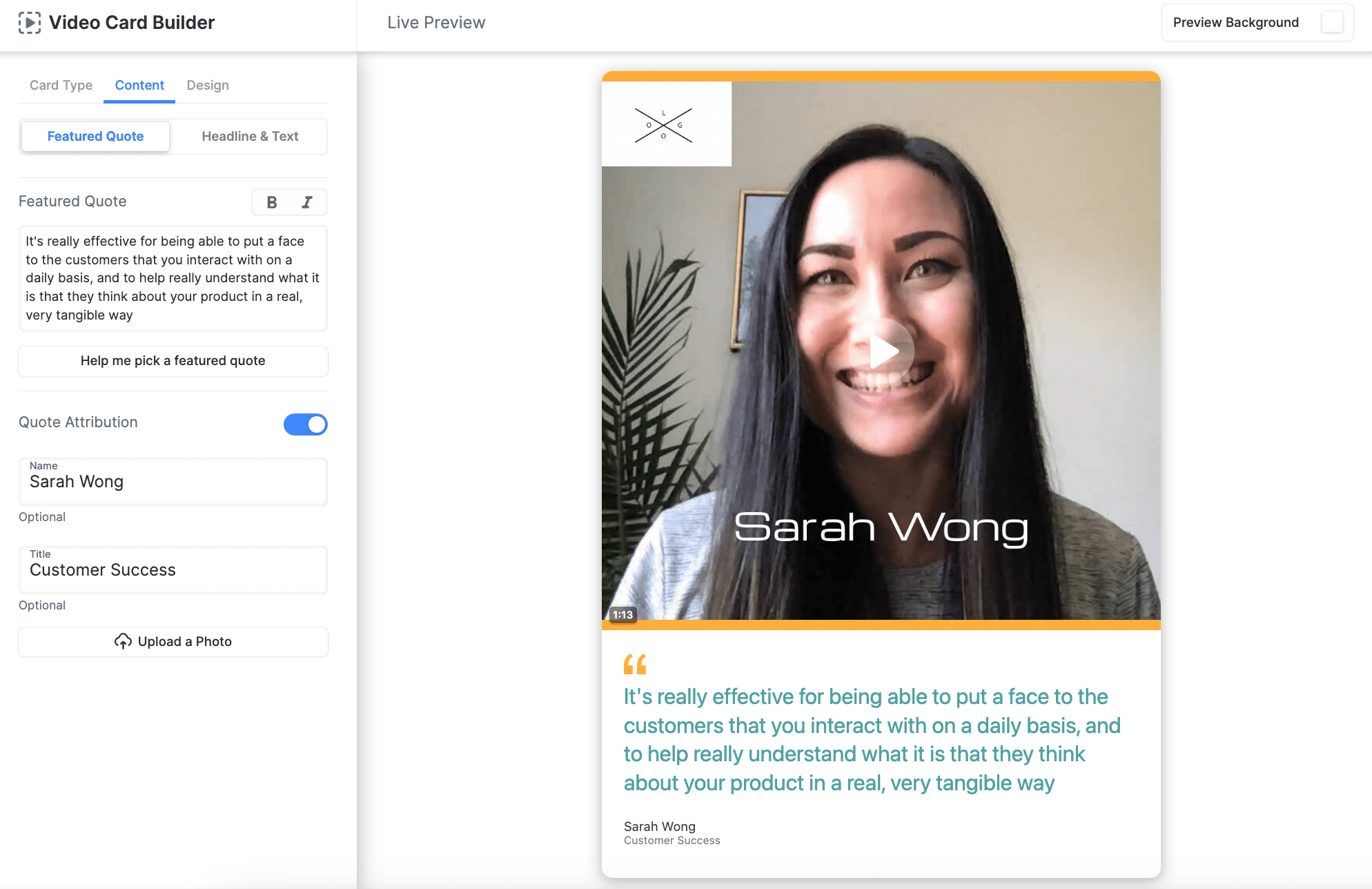
5. Add More Customer Stories with Interactive Review Carousels
When you start to build up a larger collection of video testimonials, a video carousel is a good way to break up a longer landing page and show the volume of positive feedback you have from your customers.
For example, Prepared4X uses product testimonials on their product pages. Because visitors can spool so far through the results, they get the impression that this product works for everyone, and they’re far more likely to complete their purchase.
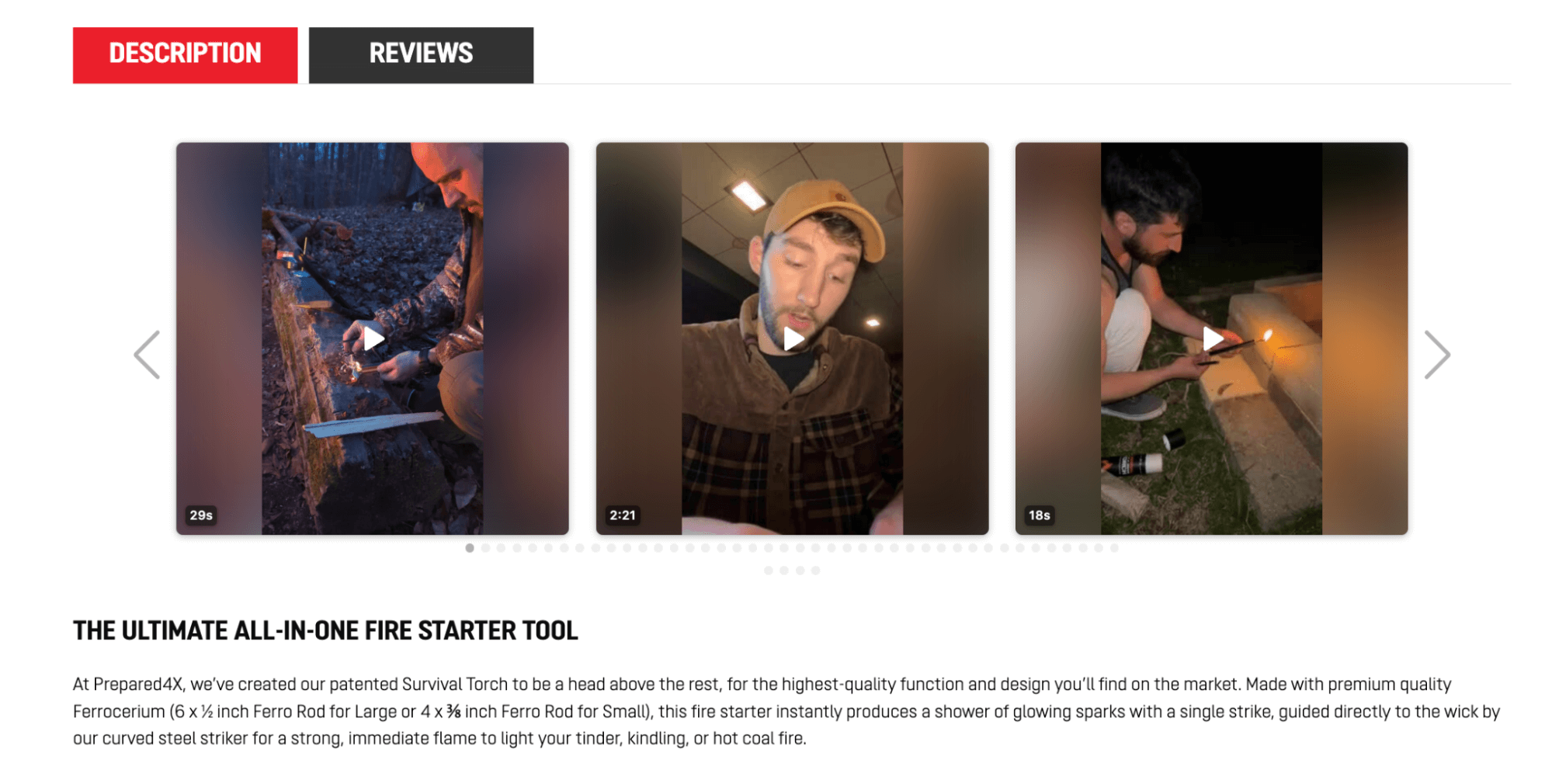
To make a testimonial carousel…
- Create a gallery and choose the “Carousel” option.
- Click “Add Videos” and choose the clips you want to include.
- Choose the design for the videos, with the option to add featured quotes.
- Go to “Embed” to preview your gallery and grab the snippet of code you need for your site.
Note: If you want to get more testimonials to build a bigger carousel, try inviting your customer list to record their thoughts using our proven 3-touch email sequence. This simple progression of pre-ask, invitation, and reminder emails makes more people feel at home with the process and can increase the number of responses you can use in your testimonial marketing.
Get template texts for our 3-touch email sequence here: How to Ask for a Review and Get More Responses
6. Build Testimonial Galleries from Drag-and-Drop Templates
When your goal is to build a testimonial page for your website, Vocal Video’s gallery templates are unbeatably easy to use. Every Vocal Video pricing plan includes five gallery templates to build your website’s testimonial page: Carousel, Slideshow, List, Grid, and Wall of Love.
For example, Story Sells uses the vertical list gallery to keep their visitors engaged with their customer stories and encourage them to scroll all the way to the bottom of the page.
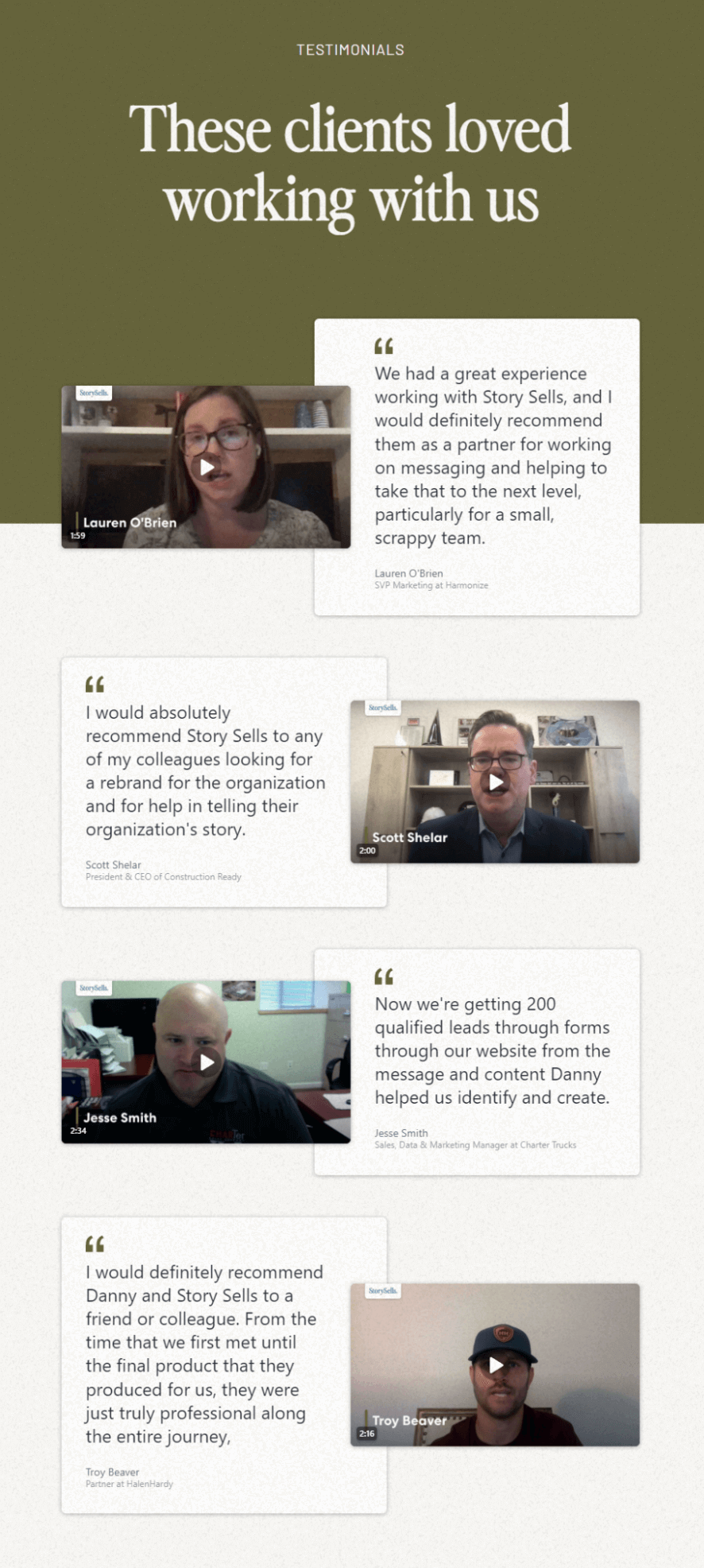
Grid galleries are a great way to display multiple testimonial videos in one place, such as on your homepage or testimonials page. Grids provide a large visual volume of social proof to impress potential customers — like this interactive example from the CFO Centre:
Finally, walls of love make every testimonial video look inviting, even when they’ve been recorded in different aspect ratios or the featured quotes are different lengths.
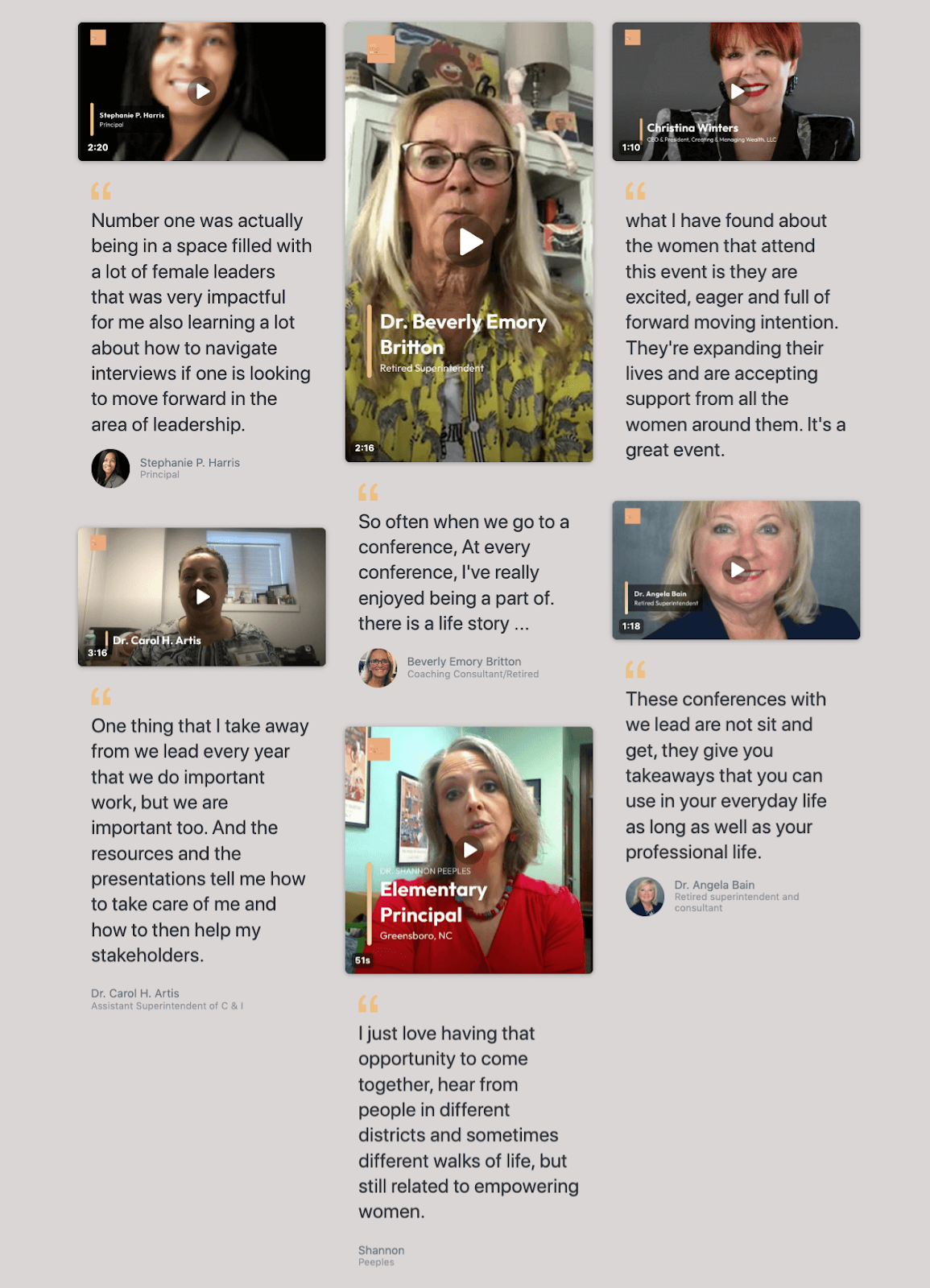
Women in Educational Leadership arrange the video testimonials they receive from their members in a wall of love format. On this homepage, the testimonials show just how many people the organization has supported and helps create the impression of an active and engaged community.
Bonus: Best Practices for Creating Testimonials
Before we close this post, let’s look at some tips to help you get the best testimonials for your website.
Choose Your Questions Wisely
The questions you add to your video collector will make or break your finished testimonial.
Imagine a question like “Would you recommend [your company] to a friend or colleague?” This question could be answered with a simple yes or no. While a “yes” is a good endorsement, it’s instantly forgettable, and it doesn’t give the potential customer any information to differentiate your business from your competitors. In a video review, short answers will also be jarring for the viewer.
It’s far more effective to choose prompts that will highlight the relatable pain points you know your business can solve, without creating the feeling that you’re leading the speaker.
Read more: You Don’t Need 25 Questions for Your Next Customer Video: Here’s Why
Ask for Testimonials in Your Follow-Up Emails
Businesses rarely say no to more user-generated content for their website and social feeds — it helps customers feel more secure in their buying decision and humanizes their brand. But unless you explicitly ask for reviews and testimonials, you won’t maximize the amount of UGC your business collects.
Try asking a customer to write or record a testimonial in your follow-up emails after they make a purchase, or in the final phases of a successful B2B partnership. When you’ve made a good impression and it’s still fresh in their mind, they’re more likely to follow through on the promise of a testimonial.
With Vocal Video, you can also incentivize your customers to record testimonials, with rewards like vouchers, charity donations, or entry into the monthly Vocal Video prize draw.
Whenever you publish a testimonial, it’s important to frame it with factual information that tells the reader or viewer they can trust what’s being said. For example:
- The speaker’s name, which makes a connection.
- The speaker’s role, job title, or relationship to your business, which signals their authority to speak on the subject.
- The date of the testimonial, so people can use its freshness as a measure of its reliability.
When you can add these facts to the testimonials you publish, the claims you make on your website will have more credibility.
Format the Videos to Fit Your Page Layout
Your testimonials should invite the visitor in, but they also need to find the rest of the information on your webpage. This means it’s important to think about how you expect the visitor to interact with your page as you place your testimonials.
For example, larger, square format testimonial videos can grab attention as the equivalent of the hero image in a news story or on a landing page, but if you want prospective applicants to see your company’s vision, values, and current openings as well as the employee testimonials, a horizontal slideshow or carousel can be a less disruptive choice.
Keep Your Videos Short and Sweet
Testimonial videos are powerful because they can convey a lot more information than text alone, but if a video is too long, your visitors are unlikely to watch it all the way through.
Keeping videos to two minutes or less tends to be the best bet for your website. If you plan to share your testimonials on social media as well, remember to check the maximum video length for each platform, as it can vary significantly.
Vocal Video allows you to easily and affordably collect video testimonials and customer reviews and gives you all the tools you need to display them in a creative and professional way on your website. You can use testimonials recorded with our templates to highlight your customer success stories, positive customer experiences, customer feedback, influencer reviews, and other types of testimonials you collect along the way.
All of our video editing and embedding functionalities are designed to be straightforward to use, even for complete novices with no web design expertise. With Vocal Video, you can start creating your own eye-catching website testimonial pages to attract new customers today.
Sign up now for a free Vocal Video account to get started.